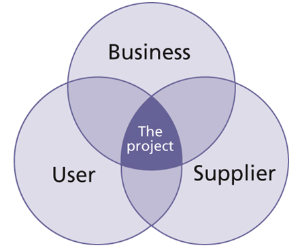PRINCE2 2009 - Organization part 2
of the Cabinet Office under delegated authority from the Controller of HMSO.
Organization defined
Project
PRINCE2® defines a project as ‘a temporary organization that is created for the purpose of delivering one or more business products according to an agreed Business Case’.
It needs to be flexible and is likely to require a broad base of skills for a comparatively short period of time.
Programme
A project can be run as a stand-alone entity or can be part of a programme of related projects.
A programme is a temporary flexible organizational structure created to coordinate, direct and oversee the implementation of a set of related projects and activities, in order to deliver outcomes and benefits related to the organization’s strategic objectives.
It is likely to have a longer life than a single project.
A project which forms part of a programme may be impacted by the programme structure and reporting requirements.
Corporate organization
A project may or may not form part of a programme.
It will, however, exist within the wider context of a corporate organization.
Corporate organizational structures can vary from ‘traditional’ functional structures, where staff are organized by type of work (for example, marketing, finance, sales etc., where there are clear reporting lines), to project-focused corporate organizations, which work with project teams as a norm, to variations in between.
Roles and jobs
In order to be flexible and meet the needs of different environments and different project sizes, PRINCE2 does not define management jobs to be allocated to people on a one-to-one basis.
It defines roles, each of which is defined by an associated set of responsibilities.
Roles might be shared or combined according to the project’s needs but the responsibilities must always be allocated.
When combining roles, consideration should be given to any conflicts of responsibilities, whether one person has the capacity to undertake the combined responsibilities, and whether any bottlenecks might be created as a result.
Three project interests
The PRINCE2 principle of defined roles and responsibilities states that a PRINCE2 project will always have three primary categories of stakeholder, and the interests of all three must be satisfied if the project is to be successful.
The diagram shows the three primary interests which make up the Project Board.
PRINCE2 recommends that for completeness the Project Board should include representation from each of the business, user and supplier interests at all times.
The products of the project should meet a business need which will justify the investment in the project.
The project should also provide value for money.
The business viewpoint therefore should be represented to ensure that these two prerequisites exist before a project commences and remain in existence throughout the project.
The Executive role is defined to look after the business interests
UserPRINCE2 makes a distinction between the business interests and the requirements of those who will use the project’s outputs.
The user viewpoint should represent those individuals or groups for whom some or all of the following will apply:
- They will use the outputs of the project to realize the benefits after the project is complete
- They will operate, maintain or support the project’s outputs
- The outputs of the project will impact them
The user presence is needed to specify the desired outputs and ensure that the project delivers them.
The Senior User(s) will represent this stakeholder interest on the Project Board
SupplierThe creation of the project’s outputs will need resources with certain skills.
The supplier viewpoint should represent those who will provide the necessary skills and produce the project product.
The project may need to use both in-house and external supplier teams to construct the project product.
The Senior Supplier(s) will represent this stakeholder interest on the Project Board.
The level of overlap between the interests of the business, user and supplier will change according to the type of corporate organization and project.
For example, if a project uses an in-house supplier, the business and supplier interests will be more likely to have overlapping interests than if an external supplier is used.
Note the term ‘customer’ is also used in PRINCE2, normally in the context of a commercial customer/supplier relationship.
‘Customer’ can usually be interpreted as a collective term for the business and user interests.
However, one example of an exception to this broad rule would be where an organization is developing a new product to bring to market.
In this case, the business interest is aligned with that of the supplier and ‘customer’ equates simply with ‘users’.
Where the user interest is external to the organization sponsoring the development, as in this example, it still needs to be represented in some way - perhaps by the sales/marketing function.
As well as the primary categories of business, user and supplier interests which should be represented on the Project Board, there will be a wider range of stakeholders which may affect, or be affected by, the project.
These stakeholders may be internal or external to the corporate organization and may support, oppose or be indifferent to the project.
Effective engagement with these stakeholders is key to a project’s success (see ‘working with stakeholders’ later in the section covering ‘Organization’.).
Further details of project management team roles and their associated responsibilities are provided in the folder ‘roles and responsibilities’ as part of the product package.
PRINCE2® is a Registered Trade Mark of the Office of Government Commerce in the United Kingdom and other countries.
Managing Successful Projects with PRINCE2 - 2005 edition
Managing successful Projects with PRINCE2 – 2009 edition
Directing Projects with PRINCE2.
plus:
The Complete Project Management package.
And much more besides - at a fantastic price.


